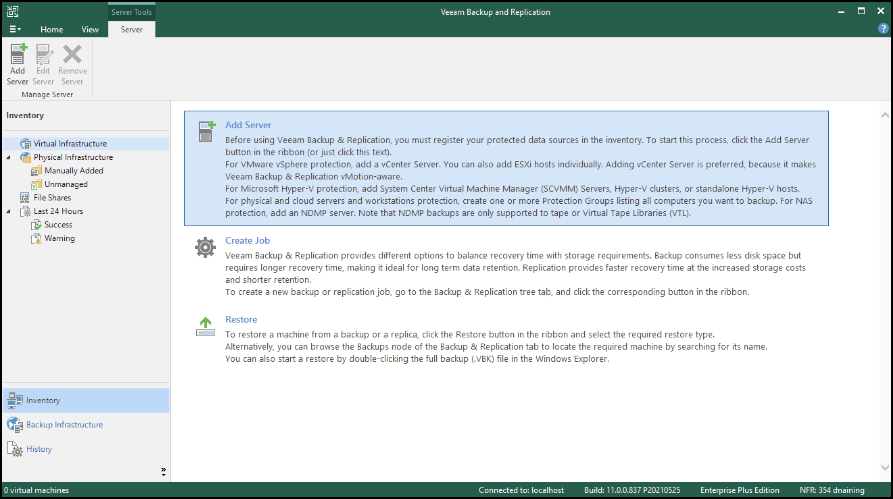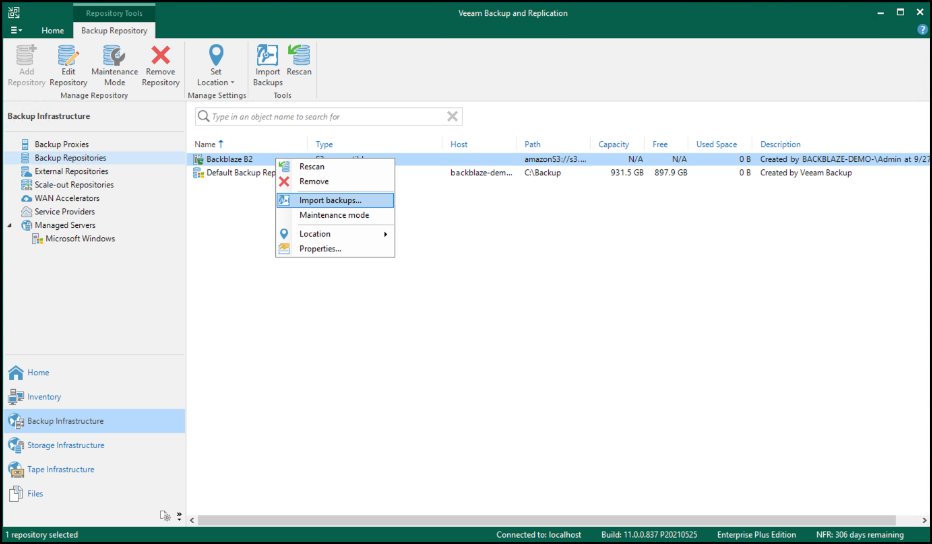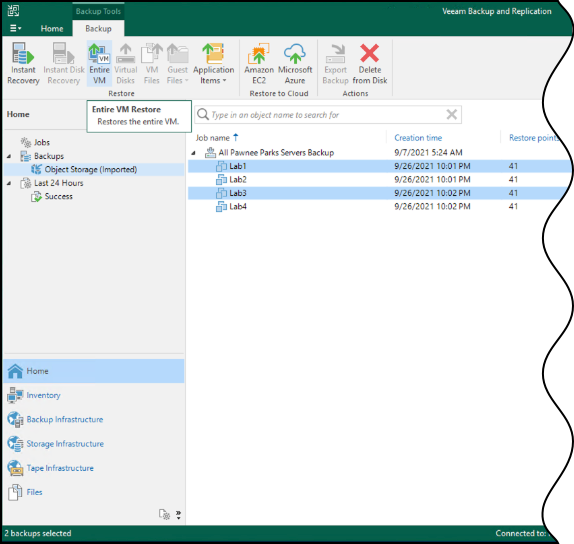- Print
- DarkLight
Veeam Virtual Machine Recovery from Backblaze B2
- Print
- DarkLight
You can recover your data from Backblaze B2 Cloud Storage when you lose access to your primary backup environment and need to recover in a completely new Veeam Backup & Replication environment wherever that may reside.
This guide applies only to Enterprise and Enterprise Plus editions of Veeam Backup & Replication and Veeam Availability Suite.
Demo Environment
This guide uses the following components in the demo environment:
- App: Veeam Backup & Replication Version 11.0.0.837
- OS: Windows Server 2019 Standard
- Compute Host: PhoenixNAP Bare Metal Cloud
- Cloud Storage: Backblaze B2
Enable a Backblaze B2 Account
Before you begin: You must have a Backblaze B2 Cloud Storage account. If you already have a Backblaze account and the left navigation menu contains a B2 Cloud Storage section, your account is already enabled for Backblaze B2.
- Sign in to the Backblaze web console.
- In the user menu in the upper-right corner of the page, select My Settings.
- Under Enabled Products, select the checkbox to enable B2 Cloud Storage.
- Review the Terms and Conditions, and click OK to accept them.
Create a Bucket
- Sign in to the Backblaze web console.
- In the left navigation menu under B2 Cloud Storage, click Buckets.
- Click Create a Bucket.
- Enter a name for your bucket. Bucket names must be at least six characters and globally unique.
A message is displayed if your bucket name is already in use. - Select a privacy setting: Private or Public.NoteYou can change a bucket's privacy settings at any time.
Files that are in a private bucket require authentication to perform an action, for example, downloading.
Public buckets do not require authentication so you can easily access files. If this is your first time creating a public bucket, complete the following tasks to ensure that you have the correct permissions to create a public bucket:
1. Verify your email address.
2. Have a payment history on file, or use the credit card form to pay a small fee that is credited to your account balance. - If applicable, enable a Backblaze B2 server-side encryption key.
- Enable Object Lock to restrict a file from being modified or deleted for a specified period of time.
- Click Create a Bucket, and copy the value that is in the Endpoint field; you may need this value later.
- Click Lifecycle Settings to control how long to keep the files in your new bucket.
On the Buckets page, note the S3 endpoint. You will need this URL to connect Backblaze B2 with Veeam.
Create an Application Key
- Sign in to the Backblaze web console.
- In the left navigation menu under B2 Cloud Storage, click Application Keys.
- Click Add a New Application Key, and enter an app key name.
You cannot search an app key by this name; therefore, app key names are not required to be globally unique. Key names are limited to 100 characters and can contain letters, numbers, and "-", but not I18N characters, such as é, à, and ü. - Select All or select a specific bucket in the Allow Access to Bucket(s) menu.
- Optionally, select your access type (Read and Write, Read Only, or Write Only).
- Optionally, select Allow List All Bucket Names.
This option is required for the B2 Native API b2_list_buckets and the S3-Compatible API S3 List Buckets operations. - Optionally, enter a file name prefix to restrict application key access only to files with that prefix.
Depending on what you selected in step #4, this limits application key access to files with the specified prefix for all buckets or just the selected bucket. - Optionally, enter a positive integer to limit the time, in seconds, before the application key expires.
The value must be less than 1000 days (in seconds). - Click Create New Key, and note the resulting keyID and applicationKey values.
Restricted Keys and Object Lock
Add Object Lock to a New Bucket
- Enable Object Lock on the bucket that you want to use.
- Create a new bucket-restricted application key.
- Configure Veeam to use the application key.
- Set the bucket as a destination.
Add Object Lock to a Bucket Already Used by Veeam
- Enable Object Lock on the bucket that is already used by Veeam.
- Create a new bucket-restricted application key.
- Configure Veeam to use the new application key on the bucket.
Add a VMware ESXi Server to Veeam Backup & Replication
Before you begin:
- Install Windows Compute Engine.
- Install Veeam Backup & Recovery on a Windows machine.

- Open Veeam Backup & Replication, and click Connect.
- Select Inventory in the left navigation menu, select Virtual Infrastructure, and click Add Server.
- Click VMware vSphere, and click vSphere.
- Enter the DNS name or the IP address of the VMware server, and click Next.
- Enter your server administrator's credentials, click OK, and click Apply.
You may get a certificate prompt. This is because VMware ESXi uses a self-signed certificate. Click Continue; you can update this certificate later. - Click Next, view your summary, and click Finish.
Add a Repository for Backblaze B2
- Open Veeam Backup & Replication, and click Connect.
- Select Backup Infrastructure in the left navigation menu, and select Backup Repositories.
- In the top menu, click Add Repository.
- Select Object storage, and select S3 Compatible.
- Enter the details for your repository.
- Enter a name for your repository.
- Enter a description for your repository, and click Next.
- In the Service point field, enter the S3 endpoint that you created in the "Create a Bucket" task.
- In the Region field, enter the second part of the S3 endpoint, for example "us-east-005."
- In the Credentials field, click Add, enter your Backblaze B2 application key, and click Next.
- In the Bucket section, click Browse, select the bucket that you created, and click OK.NoteDisable Automatic bucket creation enabled by clicking the link and clearing the Create new buckets automatically (recommended) checkbox.
- In the Folder field, click Browse and click New Folder.
- Enter a name for your folder, press Enter, and click OK.
- Select the Make recent backups immutable checkbox, and enter the number of days to lock your files.
Backblaze strongly recommends that you use the immutability feature to protect your organization from ransomware.
- To apply your settings, click Next and click Apply.
- After the items on the Apply page are green, click Next and click Finish.
The Backblaze B2 repository is displayed in the Backup Repositories section of Backup Infrastructure.
Import Backups

- Open Veeam Backup & Replication, and click Connect.
- Select Backup Infrastructure in the left navigation menu, and select Backup Repositories.
- Right-click the Backblaze B2 repository that you added in the Add a Repository for Backblaze B2 task, and select Import backups.
- On the Start the import process dialog box, click Yes.
- Click Next on the Import Backups screen, and click Finish on the Summary screen.
- To view your backups, select Home in the left navigation menu, select Backups, and select Object Storage (Imported).
Restore your VM into VMware ESXi

- Open Veeam Backup & Replication, and click Connect.
- Select Home in the left navigation menu, select Backups, and select Object Storage (Imported).
- Select one or more VMs, and select Entire VM Restore.
- On the restore wizard screen, click Next.
- Select Restore to a new location or with different settings since you are restoring the VMs to the cloud, and click Next.
- Configure the restore options clicking Nextafter each selection.
- Select the ESXi host that you created in the Add a VMware ESXi Server to Veeam Backup & Replication task.
- Select the VM resource pool.
- Select your Datastore file locations.
- Select your restore destination folder.
- Select the target network on which you want to deploy.
- Review the settings, and select Power on target VM after Restoring if you want to power on the target VMs after you restore.
- Click Finish.
Details are displayed as the restore progresses. When the restore is deployed, a success message is displayed.

On the PhoenixNAP Bare Metal Cloud, you can open the VMware ESXi web UI to see the VMs that are deployed.
